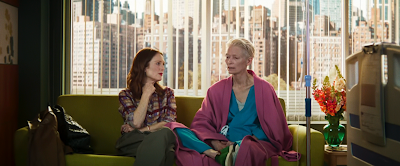What kind of hospital room has a designer olive green sofa? I suppose the same sort of hospital room that has a view of the Manhattan skyline and a festive floral painting on the wall, the sort of hospital room glimpsed in “The Room Next Door.” I am not nitpicking. No, director Pedro Almodóvar is nothing if not the master of modern melodrama, and though we tend to think of melodrama as an exaggeration of characters, emotions, and situations, in his hands, melodrama is an exaggeration of stuff too. That exaggerated stuff takes on an almost spiritual dimension in Almodóvar’s 25th feature film and first in the English language. After all, “The Room Next Door” is about a terminally ill woman, Martha (Tilda Swinton), who asks an old friend who has just re-entered her life, Ingrid (Julianne Moore), to accompany her to a luxurious rental pad in upstate New York to be take up position in the room next door where Martha plans to take control of her ultimate demise by taking her own life.
Loosely based (by all accounts, I have not read it) on a Sigrid Nunez novel, Almodóvar is less concerned with the ethics of this dramatic situation, essentially starting from a place of death being a personal situation and a personal decision. Establishing that straight away frees “The Room Next Door” to focus on the morals, of one friend putting the genuine request of the other friend first, an idea that comes alive in Moore’s performance, a true blow burn, fiery but quietly fiery. The emergent investigative subplot with a skeptical detective (Alessandro Nivola) has nothing to do with ferreting out the truth, since we already know it, and more to do with Ingrid defining her own sense of decency and truth. More than that, even, “The Room Next Door” is a contrast of light and dark, of finding the desire to go on when it’s literally hopeless to.
One might draw parallels to our current world. In fact, Almodóvar does, at least in one scene in which Damian (John Turturro), a friend and former lover to both women, notes an overriding sensation of hopelessness in the face of climate change only to be challenged by Ingrid in the face of what she’s seen being at Martha’s side. Given that it’s the only real time this subject is broached, and that Damian never feels as emotionally integrated to the narrative, it plays a little too much like a septuagenarian movie director decrying someone who is, forgive me, woke than a genuine philosophical back and forth. More’s the pity because otherwise, in the colorful world that “The Room Next Door” presents, in its finely calibrated production and costume design, from that olive green couch to Martha’s array of cozy sweaters and comfy looking soft pants, “The Room Next Door” innately expresses feeling comfort and joy in the moment and finding the wherewithal to meet your maker with the perfectly chosen lipstick on your face.
Is it strange that the most moving moment to me in the whole movie was the one when Ingrid and Martha go to Lincoln Center to see a movie? And Ingrid suggests that, hey, they better go find some seats? If I had a terminal illness, I thought, I would probably want to go see a movie too. And I would probably want to have the best seats in the house.




